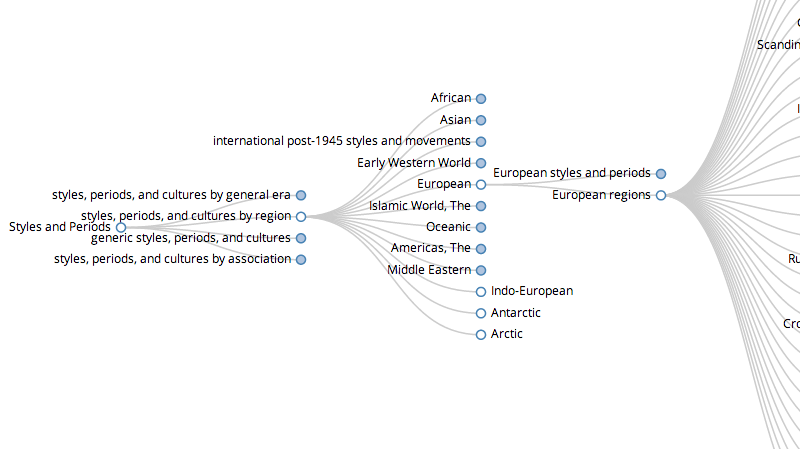Hierarchies of the Getty Art and Architecture Thesaurus
The Getty released their Art & Architecture Thesaurus (or AAT) as Linked Open Data yesterday, part of their ongoing project to publish each of their wonderfully-detailed vocabularies onto the Semantic Web. According to the Getty, the AAt is “a structured vocabulary, including terms, descriptions, and other information for generic concepts related to art and architecture.”
This vocabulary is a curious beast that covers concepts from materials and object types, to abstract concepts like physical attributes and types of organizations. While its breadth and specificity sometimes seem to verge on the ludicrous (“fireworks” can be found under “post-1945 fine arts styles and movements » Sky art”), many cultural institutions like libraries and museums find the thesaurus incredibly valuable for allowing them to tag and label their collections with standardized terms.
To give a better sense of the real scope of this vocabulary, I built a small script that walked through the AAT hierarchy and built a collapsible dendrogram that could be visualized in a web browser. Click below to open up the visualization, which works best when viewed on a full screen.

One caution: a simple hierarchical dendrogram is not the truest representation of the relationships of terms within the AAT, so some nodes here will appear to be missing subsidiary nodes because their “child” has already been assigned to another “parent”. If you want to read more about this issue, take a look at the GitHub code page, and please chime in if you have any ideas to address this! (Thank you to Vladimir Alexiev for helping to point out this issue.)
Edit 2014-03-17: The folks at the Getty have kindly updated the AAT data to resolve an issue where some nodes were listed as their own children, among other problems. I have updated both my processing code as well as the visualization on this site to reflect the new data.
I lifted the JavaScript almost wholesale from one of Mike Bostock’s D3 examples. You can see the code I used to import and query the data on GitHub. You can also download the underlying JSON for this particular visualization.
This visualization contains contains information from Art & Architecture Thesaurus (AAT)® which is made available under the ODC Attribution License. See more here.
